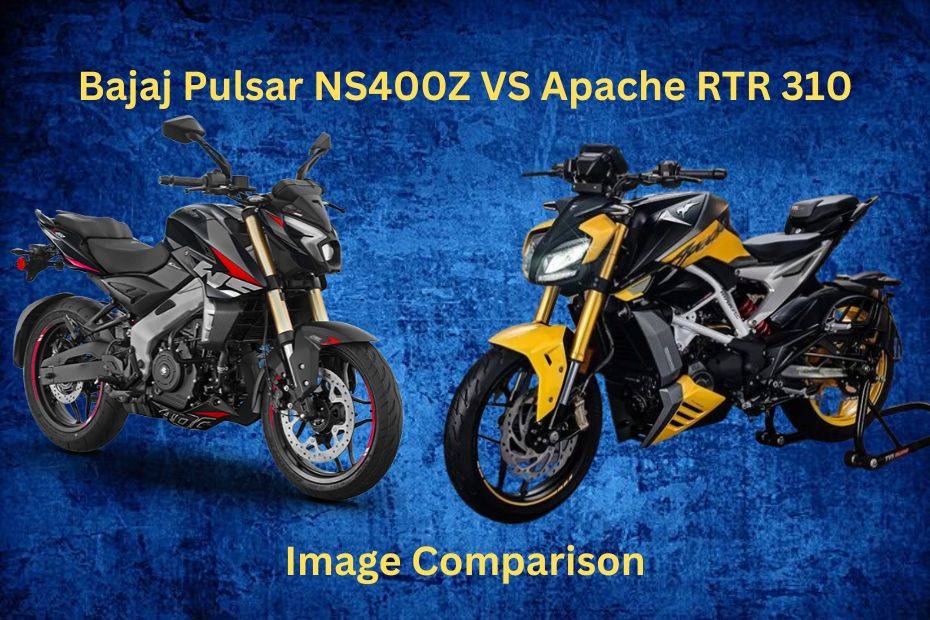Bajaj Pulsar NS400Z vs TVS Apache RTR 310: Image Comparison
Published On May 4, 2024 11:00 IST
By Govind for Bajaj Pulsar NS 400
- 6493 Views
Can the Pulsar NS400 take on the Apache RTR 310 on paper?

Bajaj recently launched their biggest Pulsar till date, the Bajaj Pulsar NS400Z. The new bike competes with other motorcycles in the 300-400cc segment and one of its major rivals is the feature-packed TVS Apache RTR 310. With this image comparison, we will be trying to find out which bike you should go for.
Design


Looks and design are subjective but even then it is hard to deny that the Bajaj Pulsar NS400, although aggressive, doesn't look like a bike in the 300-400cc segment. It just feels like a larger Pulsar NS200, with the same overall design and a different headlight.
The Apache RTR 310 on the other hand has a proper big bike feel, thanks to the design inspiration from the Ducati Streetfighter V4. The bike stands out and overall has a road presence that the Pulsar NS400 cannot match.
Engine & Performance
The Pulsar NS400 comes with a larger 373.3cc liquid cooled, single-cylinder engine that produces 40PS and 35Nm.
Whereas the Apache RTR 310 is powered by a smaller 312.7cc, liquid-cooled, single-cylinder engine producing 35.6PS and 28.7Nm. If you are someone who prefers function over form, then the winner here is quite clear and it is the Bajaj Pulsar NS400.
Underpinnings

The TVS Apache RTR 310 has a fully-adjustable 41mm upside-down (USD) fork and rebound and preload adjustable monoshock suspension setup. Braking duties are taken care of by 300mm front and 240mm rear petal disc brakes with dual-channel ABS as standard.
The Pulsar NS400 on the other hand, features a frame that is derived from the Bajaj Dominar 400. It is suspended on a 43mm inverted fork and a gas-charged monoshock. Braking setup consists of a 320mm front and 230mm rear disc brake, with dual channel ABS.
In this case, the NS400 has the bigger front fork and larger brake discs. But the Apache RTR 310 has the edge here as it offers the option to tune the suspension to the rider’s preference, making the bike a bit more versatile.
Features

Starting with the console, the Pulsar NS400 comes with a colour LCD console with a TFT inset on the right. The console displays readouts like speed, fuel level, tachometer readings along with trip/odometer readouts. The console comes with smartphone connectivity and gets related functionalities such as turn-by-turn navigation and Call/SMS alerts.
The NS400 also offers 4 riding modes – Road, Sport, Rain and Off-Road – and also gets a traction control system.

The Apache RTR 310 on the other hand features a 5-inch TFT console and offers a lot, from smartphone connectivity and related features like turn-by-turn navigation and Call/SMS alerts to even document storage for 3 documents like licence and registration certificate.
In terms of riding modes, the RTR 310 gets 5 riding modes: Urban, Rain,Track, Sport and Supermoto. It also gets cruise control, cornering ABS, cornering cruise control, rear lift off control, slope dependent control and front lift-off control. It's safe to say the list of features is just exhaustive. For a better understanding of what the RTR 310 offers, check out our explainer here.
Conclusion

Both the NS400 and the Apache RTR bring different things to the table, and which one is better depends on what you are looking for from your motorcycle.
The NS400 should offer better performance, with a modest set of features at a very affordable price. So if performance is more important to you then the NS400 is the better choice.

What the TVS Apache RTR 310 brings to the table is that big bike feel while also offering a ton of features that you won’t find on litre-class motorcycles. If looks and features are what’s important to you then the RTR 310 will be the right choice.
